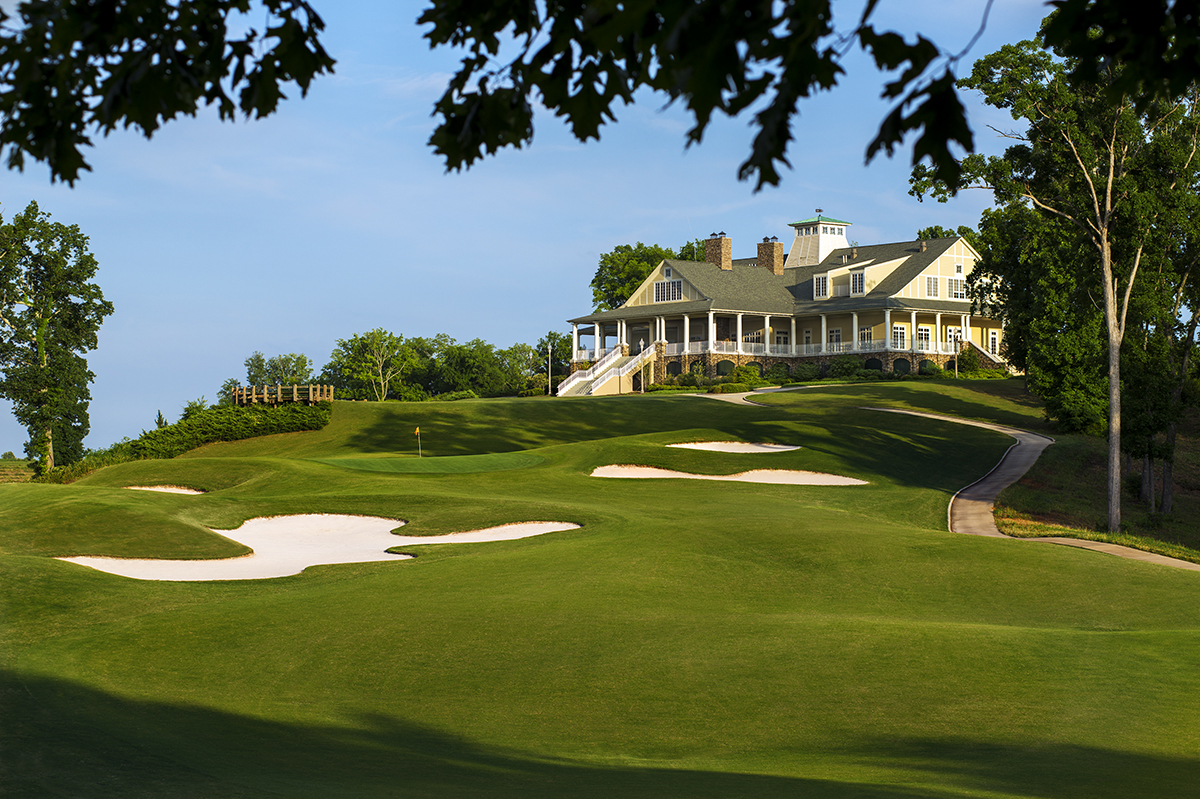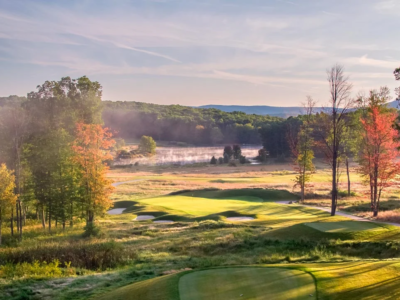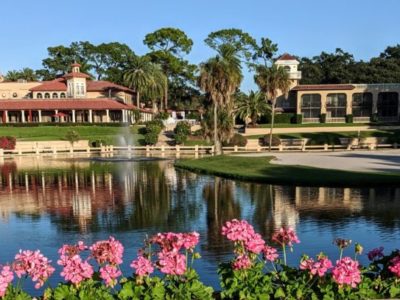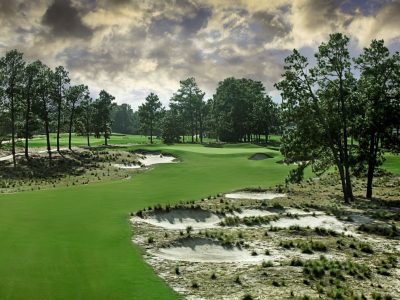Landscape like northern Michigan but with a longer season.
Due to the influence of the Appalachian Mountains to the east, northern Alabama is very hilly and sometimes mountainous – making for great golf and other outdoor activities for visitors from the Midwest.
The Robert Trent Jones Trail is a well-documented collection of 26 golf courses designed by the legendary architect and crew of the trail’s namesake. It was developed by the Retirement Systems of Alabama with a goal of making money for its membership’s pension fund but to also add golf courses in various communities that would spur additional economic activity around them.
Mission accomplished.
Here is one recommended golf itinerary in the northern one-third of the Heart of Dixie State:
Goose Pond, Lakes Course in Scottsboro:
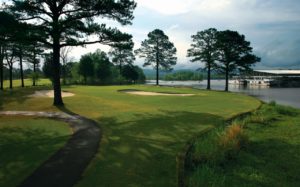 Situated near the Tennessee River, water can be seen from all 18 tees at Goose Pond’s Lake Golf Course, but most are for show. Only in a handful of times does water become a hazard on the layout so it’s more for aesthetics – and that’s okay.
Situated near the Tennessee River, water can be seen from all 18 tees at Goose Pond’s Lake Golf Course, but most are for show. Only in a handful of times does water become a hazard on the layout so it’s more for aesthetics – and that’s okay.
Favorite stretch: holes 13-15. The 13th is the signature par 3 that has a forced carry over a small inlet of water – a portion that’s connected to one of the many marinas that enter Guntersville Lake. The 14th is a par 4 that goes uphill and makes a sharp right turn downhill to the green and more views of the hundreds of docked boats. The 15th hole is a long par 5 that runs along a Tennessee River tributary on the right, with a pond in play near the elevated green on the left. Par on any of the three holes is a great score.
On-property waterfront cottages make for nice overnight accommodations and Guntersville Lake is well known for excellent bass fishing.
Hampton Cove, Highlands Course in Huntsville:
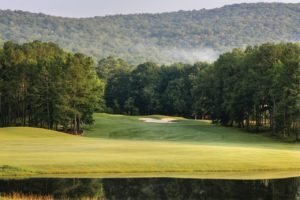 Hampton Cove is settled in a highland area that’s surrounded by mountains on all four sides, making for excellent panoramic views of the area, littered with a nice mix of sand bunkers and water hazards.
Hampton Cove is settled in a highland area that’s surrounded by mountains on all four sides, making for excellent panoramic views of the area, littered with a nice mix of sand bunkers and water hazards.
Arguably the most interesting stretch is holes 4, 5 and 6. The 4th is a downhill par 3 that is reminiscent of many Up North courses, followed by a par 4 that goes slightly uphill as the fairway wraps around an old barn on the property that literally sits on the edge of the short grass – no doubt making it the most unique “hazard” I’ve encountered in golf.
The 6th hole is a downhill dogleg left par 4. From the tee there’s an incredible view of the rest of the property (as does the 10th tee) with a stand of tall southern pines lining the fairway.
The Shoals; Fighting Joe Course, Muscle Shoals:
 This is the RTJ Trail’s best example of a links course as most Trail designs statewide are cut through wooded land. Holes 7 and 17 are the only ones that truly have trees come into play off the tee; four more holes have trees framing their greens but otherwise the design is wide open. The course overall is reminiscent of Eagle Eye in mid-Michigan with its mix of water, open spaces and limited, but effective, wooded areas.
This is the RTJ Trail’s best example of a links course as most Trail designs statewide are cut through wooded land. Holes 7 and 17 are the only ones that truly have trees come into play off the tee; four more holes have trees framing their greens but otherwise the design is wide open. The course overall is reminiscent of Eagle Eye in mid-Michigan with its mix of water, open spaces and limited, but effective, wooded areas.
A solid stretch of golf is the 5th, 6th, 8th and 9th holes, with a serious risk-reward opportunity on the 17th par 5 and 18th par 3 hole over a huge gorge to make a stout finish to any round. This 36-hole property’s finishing holes also bring into view the Tennessee River but this time on the far west end of the state.
The official hotel is the Marriott Shoals Hotel and Spa and ranks as one of the best in the brand’s lineup across the country.
Silver Lakes, Gadsden:
Silver Lakes went from a tree-lined layout to about one-third open links style in 2011 when an EF4 tornado ripped across the course and tore up or damaged 40,000 trees – eventually causing $2.4 billion in damage across Alabama.
The cleanup and stump removal on portions of the first and second of three 9s gave an entirely new feel to the course – and some would argue a refreshing balance in design.
Silver Lakes is wide, long and bold, with many extremely elevated green complexes that almost always require clubbing up two. Once reaching the enormous greens, many are formed with spines that cause a look like waves rolling across the putting surface. The trees that remained nicely frame each hole but don’t intrude unless a shot goes way off target.
Terri Pines Country Club, Cullman:
This private club enjoys having guest play, and believe me you’ll enjoy it.
It’s not officially on the RTJ Trial but the designer, Tom Jackson, was a disciple of Jones. Jackson took the severely-rolling terrain of a former tree farm in 1979 and shaped a layout that looks and feels like it was built in 1929. The course is not long, maxing out at 6450 yards – and for Michigan players it could feel like a shorter and tighter version of Shepherd’s Hollow in Oakland County.
There simply is not a bad hole on the course, so picking the best is nearly impossible. But a good stretch of three would be holes 7, 8 and 9. No. 7 requires a tempered tee shot to not go too far and into a deep gorge, but the approach shot over the river is a very reasonable distance to a receptive bent-grass green. No 8 is an attractive par 3 surrounded by trees – as most holes are – before the 9th hole par 5 goes somewhat uphill and doglegs right.
Overall the extreme elevation drops and rises, and tall pines framing most fairways, makes for a half day of visual enjoyment even if golfers don’t strike the ball well. With only 18,000 rounds played all year it’s in terrific shape for those wanting to be a guest for the day.
For that matter, anyone who is a guest visiting Alabama should go home feeling glad they were.
Alabama Rolls Out the Barrels
By Tom Bedell
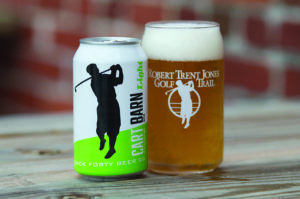 In terms of craft beer, the U.S. south was still so deep early in the 21st Century that it was submerged in a sea of Bud Light and other watery mass market lagers. Remnants of Prohibition still clung to many southern states like moss on a live oak. But the times at last are a-changing, and so are regulations that once inhibited a new brewing scene from stepping up to the bar, so to speak.
In terms of craft beer, the U.S. south was still so deep early in the 21st Century that it was submerged in a sea of Bud Light and other watery mass market lagers. Remnants of Prohibition still clung to many southern states like moss on a live oak. But the times at last are a-changing, and so are regulations that once inhibited a new brewing scene from stepping up to the bar, so to speak.
Nowhere is this more evident than in Alabama. From a few drops of craft beer in the barrel in 2011, Alabama became the fastest growing craft beer state in the nation over the next five years, surpassing 60,000 barrels produced according to Brewers Association statistics, for an astronomical growth rate of 6,380 percent!
Northern Alabama has led the charge, particularly around Huntsville, to the extent that north Alabama’s tourist association (http://www.northalabama.org) has created an itinerary of breweries that can be—for now—visited in a dedicated weekend’s time (bringing a designated driver recommended). Get a stamp from each on a brewery passport and you’re in commemorative gift territory.
Once we put the sticks away our brewery itinerary included Straight to Ale and Yellowhammer in Huntsville, Singin’ River in Florence, Goat Island in Cullman and Back Forty in Gadsden. We dipped into beers as variously named as Monkeynaut IPA, Frankenhammer, Pugilistic Zombie, IPAcalypse Now, Son of a Bridge Jumper and Naked Pig Pale Ale, and all just as varied in style and flavor. The beers were uniformly good and the back-story brewery yarns equally refreshing. The point of drinking mass market belly wash in Alabama from here on out was inherently rendered pointless.
The very notion of a beer trail clearly borrows from the success of the state’s Robert Trent Jones Golf Trail. The Back Forty Beer Company of Gadsden, having first produced its Naked Pig Pale Ale in 2009, is the oldest of the northern Alabama craft breweries, and its Cart Barn Light cream ale can be found at all RTJ Trail sites in a can that resembles the Trail logo.

